SAP SE – Project Insights & Research Results
While data-driven services are already widely used in various industries in the context of Industry 4.0, in healthcare the use of networked machines and data is still in its infancy. The OP 4.1 initiative sought to address exactly this and takes a step beyond Industry 4.0. The prototype shows how companies of all sizes could leverage its technical and commercial basis for the development, distribution, and simple implementation of innovative apps in the operating room environment. Learn how the innovation skillset of various SAP teams contributed to this endeavor.
As integrated part of the project scope, the AppHaus team envisioned a design showcase for intuitive interactions of the surgery team, creating a design and interaction concept for the so-called Operating Room (OR) Dashboard and the apps used in the context. For the service-based platform as well as the dashboard, the Innovative Business Solutions Organization (IBSO) joined as a trusted solution architect, development and design partner. During the 2.5-year project phase both teams got great support from various other SAP teams including Health Development and Central Research Services.
Field Research to Ensure Human-Centered Innovation
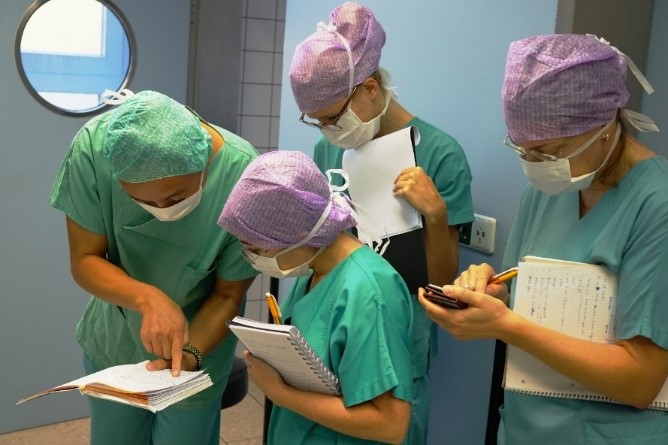
SAP team conducting research during the OP 4.1 project
As a first step in the project, based on SAP’s Human-Centered Approach to Innovation the SAP team conducted a thorough evaluation of operating room procedures and tasks to understand what the hospital team needed and desired. Some challenges were identified during user research such as the fact that doctors must memorize and conceptualize all relevant data in their heads before standing at the operating table and performing the surgery.
Ultimately, we wanted to research how OP 4.1 could provide relevant information at the right point in time, and in an easily consumable manner to better support the OR teams.
– Michaela Epp, SAP project manager
Designing the Prototype
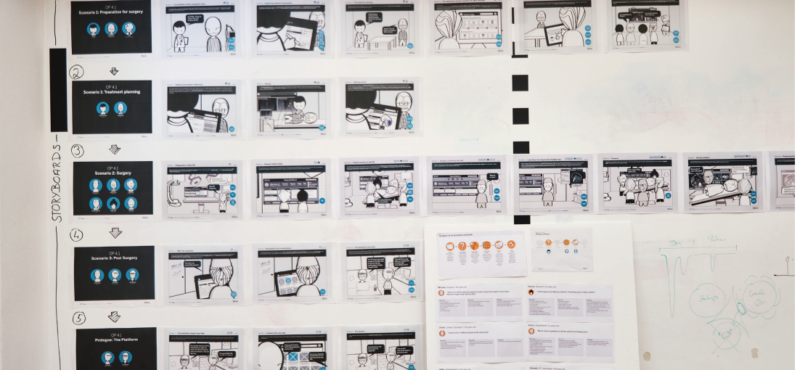
To-be process visualization
The research results were summarized in an as-is-process view with the patient’s journey: from making a surgery appointment to leaving the hospital, with a focus on the OR processes. With the help of SAP Scenes, a method of SAP’s innovation toolkit, the team created a storyboard to describe the to-be process for all project partners. This board was then used to validate the process and the integration needs with hospital staff including IT and project partners. As a next step, user stories were created for the IBSO development team to transfer the lessons learned from research. The dashboard prototype and the design for the so-called Starter Apps by the partners were initially conceptualized with hand-drawn mock-ups and validated with the physicians jointly by AppHaus and IBSO designers.
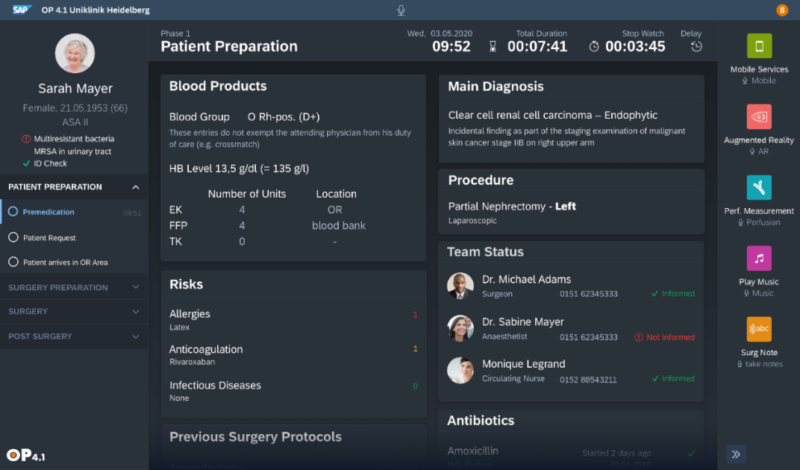
Dashboard prototype screen providing information per surgery phase
Mapping and Visualizing Complex Data Based on SAP Fiori 3
Based on SAP Fiori 3, the dashboard prototype provides a comprehensive way of mapping complex data sets and visualizing data at the right point in time. The Fiori 3 Dark Theme was used as a basis for providing a non-distracting display in low-light surgeries. Various interaction concepts like gesture control were also tested. In the end, voice recognition was used to set timestamps and launch apps, eliminating the surgeon’s need to get help from others to interact with the software on his or her behalf. As a back-up solution, interaction via touch or a mouse is still available. What’s more, it is possible to record voice memos during surgery which are then transcribed and stored as text. In the future, this text can be integrated into the surgery protocol to save time and improve data quality. In addition, information from outside the surgery room, like push notifications for laboratory results, can also be integrated. The surgery summary provides an overview on time stamps like incision-to-suture-time, app and medical device usage etc. This data could also be anonymized and used for quality assurance and KPI reporting.
Camila Lombana, SAP AppHaus Strategic Designer created a design and interaction concept for the third-party medical apps. She tested, validated, and created a framework to help release safe medical user interfaces (UIs) for the OR. The concept seeks to facilitate and speed up the development of third-party applications by leveraging an extended version of SAP Fiori 3 UI for the operating room.
Legal Requirements Gathered in a Data Protection Concept
In addition to the design concepts, the SAP AppHaus team defined the data protection concept for the OP 4.1 context. For the prototype, the project team did not use actual patient data. Nonetheless, patient data protection and consent management are legal cornerstones of the medical field. Thomas Obert, SAP Development Expert, consulted with developers, medical and legal professionals as well as project partners to ensure all legal facets were covered. The data protection concept he and the team put together took all data protection regulations for patients as a frame of reference by using the EU’s General Data Protection Regulation (GDPR), Federal Data Protection Act (BDSG), National Data Protection Law (LDSG BW) and the Country Hospital law of Baden-Württemberg. Moreover, the concept provides developers with a helpful checklist of data protection requirements they can use whenever they build an app.
New Market Opportunities for Software Innovations in the Operating Room
SAP Business Technology Platform was the starting point for OP 4.1’s technical integration, but the project’s commercial component also needed to be addressed. “For this, SAP Subscription Billing was integrated as a billing solution that helps to plan and adapt business models with speed and agility. This setup allows for flexible charging models such as pay-per-use,” explains Timo Gramlich, SAP Solution Architect IBSO, “On-premise components of OP 4.1 and medical devices such as endoscopes were connected to the platform using SAP Internet of Things capabilities, thus introducing Industry 4.0 standards into the medical area.” By collecting sensor and usage data of medical devices as well as from the starter apps and platform services, different charging models and scenarios are supported by the OP 4.1 platform.
The project team developed the business models for the platform and supported the partners with new business model possibilities. The service-based platform business model could also be modified to fit other industries.
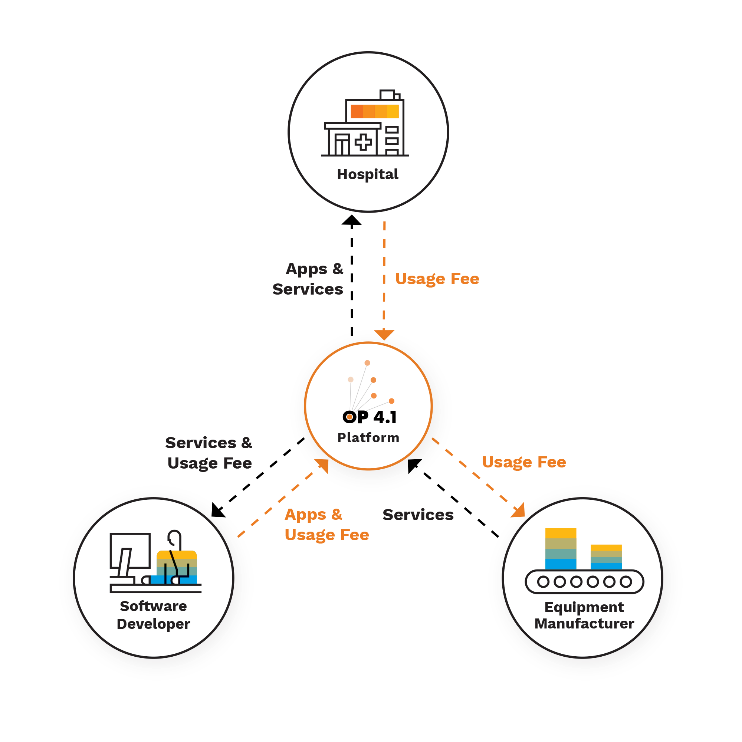
OP 4.1 Business Model
Successful Project Closure
The prototype of OP 4.1 is intended to show how such a platform can be used in the future as a basis for the development, distribution, and implementation of innovative applications in the operating theatre environment for other companies.
On the one hand, these new solutions can support hospitals in making their processes more efficient and reducing the workload of their staff. On the other hand, they can improve the treatment of patients as well as its outcome, in the future.
Project results were presented on January 28th at the closing event with a demonstration of the OP 4.1 prototype to a large audience in Heidelberg.
This OP 4.1 project was part of the technology program „Smart Service Welt II“ that was funded by the German Federal Ministry for Economic Affairs and Climate Action.

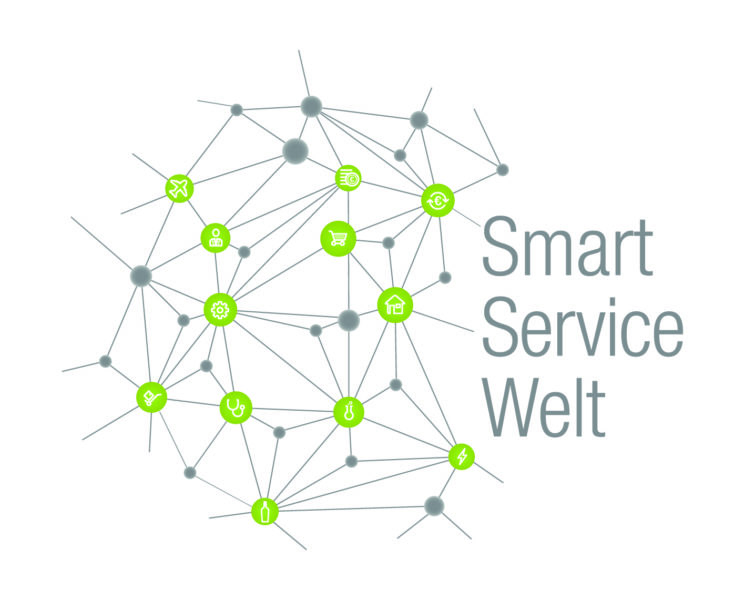
SAP Business Technology Platform
The following summary sheds light on the SAP technologies used and how they demonstrate the value of SAP Business Technology Platform.
Business Centricity
- Use of SAP Consent Repository service and other business services to add certain business process knowledge to platform features
- Realized device usage scenario based on SAP Internet of Things to get from pure usage data (on/off) to business value (e.g. pay-per-use charging and billing)
Unified Platform
- Design Concept for Dashboard built based on SAP Fiori 3 to support surgery process documentation e.g. with timestamp tracking
- OP 4.1 API hub based on SAP API Management to provide platform features, data and functionality to partners and customers
Open Architecture
- Enabled Docker container deployment on SAP Business Technology Platform for partners to easily bring and run apps on the platform
- Hybrid SAP Cloud solutions connected to an on-premise partner gateway via SAP Edge Services
